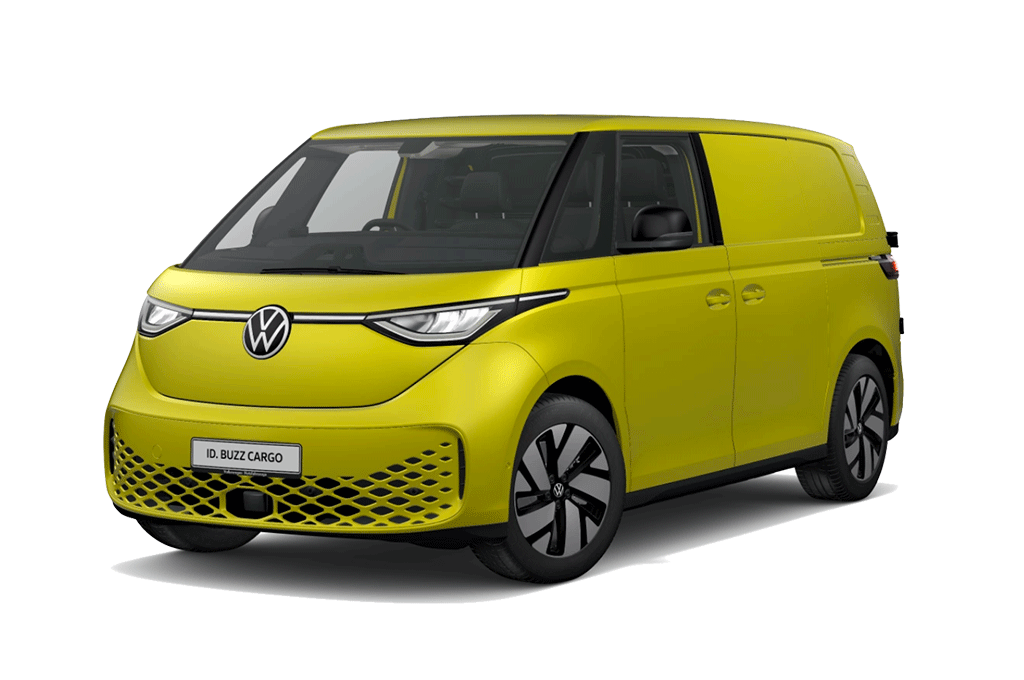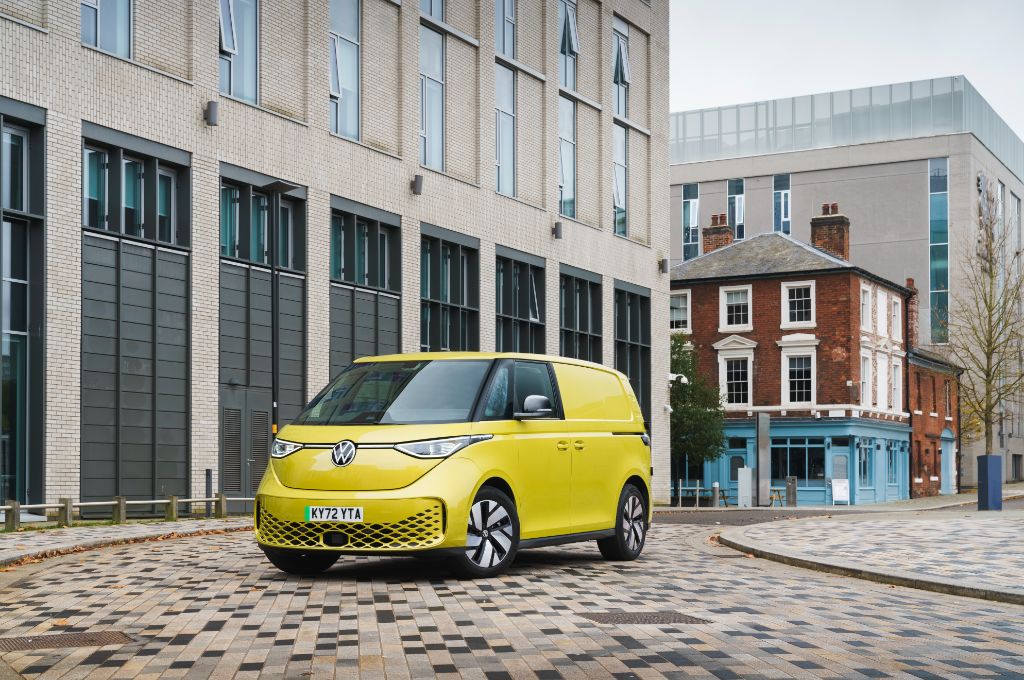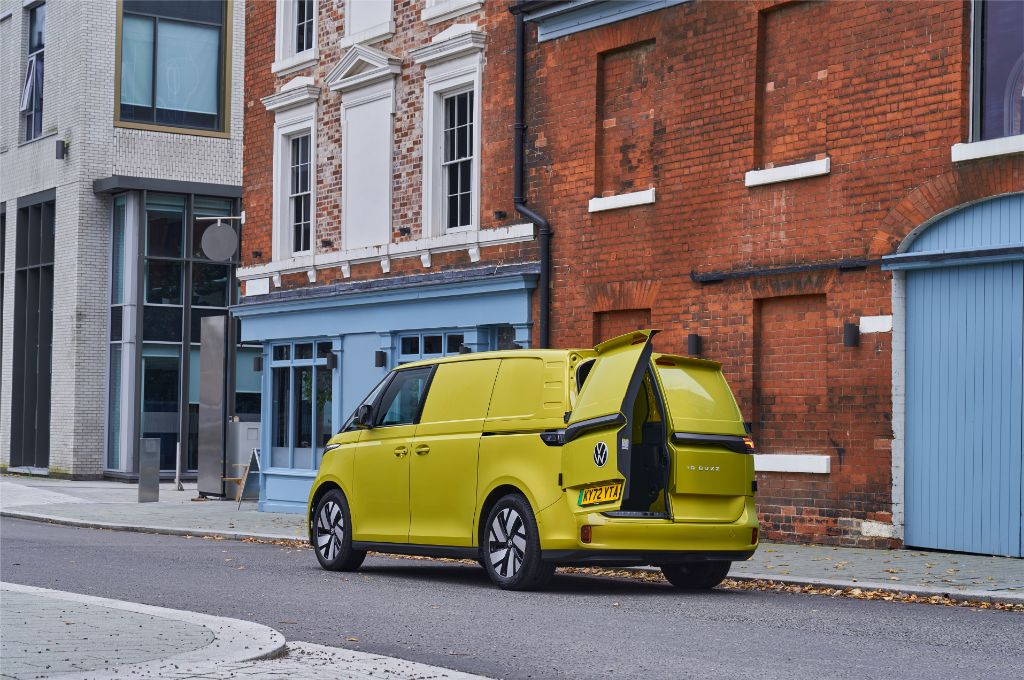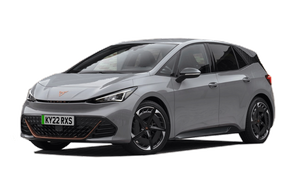It's not hard to see where the design inspiration for the ID. Buzz came from. A fully electric reboot of the classic 1949 Type 2 – the vehicle that went on to become the Volkswagen Transporter – the Buzz was previewed by a concept of the same name in 2017. And now, five years on, the ID. Buzz Cargo is finally available as both a panel van and a five-seater MPV.
In the metal, the VW ID. Buzz Cargo is a glorious piece of design. Yes, there are some elements that have been compromised to ensure compliance with crash regulations and the like, but the final production ID. Buzz is impressively close to the concept - especially in the fabulous two-tone yellow paint option.
The five-seater and van models are the first of numerous planned variants that will eventually form an ID. Buzz range. Seven seater and longer wheelbase models are arriving shortly, along with the version everybody wants (but few will be able to afford): the ID. Buzz California camper van.
VW ID. Buzz Cargo design
The VW ID. Buzz Cargo is based on the same foundations as all the Volkswagen Group ID models. Known as the MEB platform, this is effectively a giant skateboard with the wheels, suspension and motors at one end and the battery pack in the middle. To help ensure that the platform doesn’t compromise the design of the cars on which they are based, Volkswagen engineers can tweak the wheelbase (the distance between the wheels from front to rear). As a result, the ID. Buzz has a longer wheelbase (2,989mm vs 2,771mm) than the ID.4.
At the front, The Cargo's LED headlights wrap around into the bodywork to give an art-deco look while the signature front light strip runs between the headlights and through the big VW badge. Then there’s a full-width grille at the bottom beneath the badge which includes a slightly awkward-looking sensor for the radar cruise control and other automated driving functions.
The front doors are hinged as normal, while the rear has sliding doors either side. While European models only have a single sliding door fitted as standard, UK versions get a twin door set up as standard. The doors are on the heavy side, but no worse than on other vans. However, if you fancy an easier life, Cargo customers can specify them with power opening and closing by dipping to the extensive options list.
At the rear, there’s a vast single-piece tailgate that gives great access to the very big and very square load area. The tailgate comes unglazed as standard, with customers able to add a window in the top panel as an option, or choose twin barn doors. The latter is arguably the most practical as it liberates an extra few mm of load length and is better suited to urban deliveries and depots with bays, where opening the tailgate is more of an issue.
The Cargo's load cube has a capacity of 3.9 m3 and provides enough space for two Euro pallets. The maximum payload of the Commerce is 607 kg while the higher spec Commerce Plus has a payload rating of 592 kg – both decent figures that are on a par with other electric vans. Loads can be secured via a host of lashing rings in the floor and rails on the side walls - the former of which is lined with plywood as standard. The Cargo comes with a loading length of 2,208 mm when equipped with a tailgate and 2,232 mm when specified with wing doors. The loading sill is 636 mm from the floor while the twin sliding doors have a loading aperture of 756 mm.
The cab is separated from the load cube by a solid bulkhead that can be optionally specified with a shallow window. The dashboard layout differs slightly from that offered on the MPV version of the Buzz with a simpler layout and black materials in place the passenger version's bright colours. Customers can choose between a three-seater layout (two-seater bench and driver's seat) or two individual seats as a no-cost option. The dashboard stretches out in front of the cab and despite covering a huge area, is cleverly detailed and neatly laid-out. The cockpit in front of the driver is formed by a free-standing 5.3 inch ID.Cockpit display. Positioned centrally in the middle of the dashboard is the ‘Discover Pro’ infotainment system which has a standard 10-inch touchscreen. The optional Infotainment Package Plus offers a larger 12-inch screen.
VW ID. Buzz Cargo driving
Thanks to its MEB foundations – it shares its underpinnings with the ID.3 and ID.4 – the ID. Buzz delivers a smooth and refined driving experience. The ride quality, especially on the standard 19-inch Tilburg alloy wheels fitted to the Commerce Plus version, is composed over small bumps and equally adept at smoothing out bigger undulations. The steering is pleasantly weighted and Volkswagen’s engineers need to be congratulated for giving the ID. Buzz a turning circle of just 11.1 metres. It might sound like a relatively meaningless stat, but given its length and width, the fact that it can out manoeuvre much smaller cars in tight spaces is a real bonus.
For electric vehicles owners used to hearing about new models with sub-five seconds 0-62mph times, the ID. Buzz with its 10.2 seconds benchmark might sound like something of a pudding. However, once behind the wheel, that figure feels somewhat misleading. Acceleration from rest is lively and there’s a useful shove of torque if you need to make any overtaking manoeuvres. While the ID.4 is quicker on paper (0-62mph in 8.5 seconds), the ID. Buzz feels just as rapid and agile.
Like other ID. models, the Buzz Cargo comes with a rather gentle regen system that will feel almost non-existent to drivers who have sampled a more focussed one-pedal driving setting. Activated by selecting ‘B’ on the gearshifter, it feels barely noticeable at higher speeds and would benefit from being more powerful at urban speeds. Using the brakes, even on modest downhill sections, feels like a waste of energy that could otherwise be fed back into the battery pack.
Thankfully, the friction brakes are more than up the task. Although the ID. Buzz Cargo Commerce Plus tips the scales at a porky 2,408kg (Commerce - 2,393kg) and has drums at the rear, the braking system feels powerful and can bring the Buzz to a halt with impressive speed.
Should you fancy a spot of towing, the Buzz can be specified with a retractable tow bar that can handle up to 1,000kg.
VW ID. Buzz Cargo battery, range and charging
The ID. Buzz Cargo launches with a single 77kWh battery pack and features a 201bhp motor that drives the back wheels. It’s mechanically identical to the set-up you’ll find in an ID.4, ŠKODA Enyaq and Cupra Born. However, the ID. Buzz is the first of Volkswagen’s ID models to come with a 170kW rapid charging speed. Although all 77kWh models in the range will be able to charge at this higher rate, the Buzz is the first to benefit from the speed increase.
In reality, it means that a charge from 10-80% will take around 30 minutes when hooked up to a 170kW+ rapid charger. The ID. Buzz Cargo comes with an 11kW AC charger even though most domestic users will only be able to draw 7kW from a home wallbox.
In terms of range and consumption, the ID. Buzz Cargo is okay but not great. Although the ID.4 enjoys a WLTP range figure of well over 300 miles, the Buzz Cargo’s official figure is just 256 miles. Although our routes were largely A-roads and urban areas, we averaged a disappointing 2.5 miles per kWh. That would give a theoretical range of just under 200 miles, which could be an issue for drivers looking to switch from diesel models with significantly longer driving ranges.
VW ID. Buzz UK range and pricing
The ID. Buzz Cargo is available with two trim levels, Commerce and Commerce Plus. The entry-level Commerce starts at £48,541 (with the VAT added, but not including PiVG deductions) and while the Commerce Plus costs £53,641 (RRP inc VAT and OTR). For the latest monthly offers on this or any other van, with free fast delivery, call our partner Vanaways on 0800 368 3286. The Commerce comes with air conditioning, twin sliding doors, heated driver's seat and multi-function steering wheel as standard. in terms of safety kit, all ID. Buzz Cargo models come with Autonomous Emergency Braking Front Assist with Pedestrian and Cyclist Monitoring an eCall emergency system. Higher spec Commerce Plus variants include Discover Pro navigation and infotainment system body coloured bumpers and a heated windscreen. Look out for some keen deals though - it seems the Buzz hasn't been quite the success VW hoped and sales are slow. This means they are loading up the offers.




























